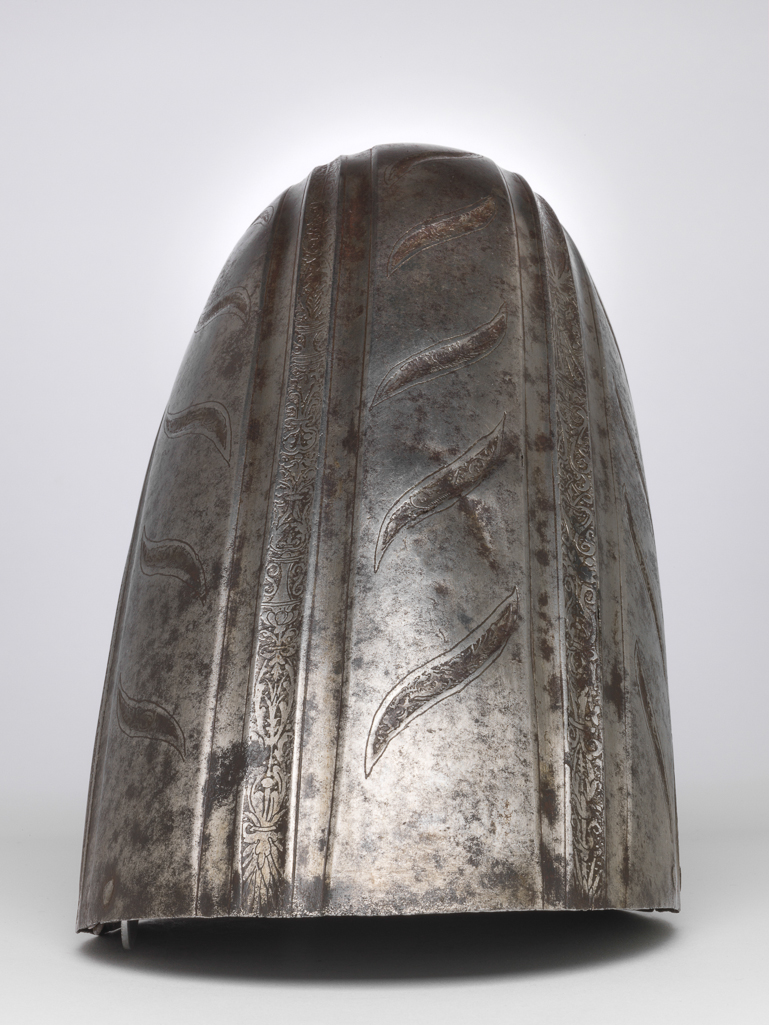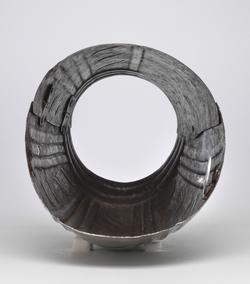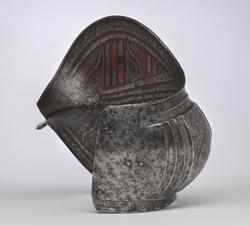Current Location: In storage
Maker(s)
Armourer:
Helmschmied, Koloman
(Possibly)
Entities
Categories
Description
Couter and lower cannon of a vambrace for the right arm, for parade use, with 'puffed-and-slashed' decoration in imitation of civilian costume. The couter is formed of a single, large, shell-like plate, open at the rear and strongly shaped to the point of the elbow. Its outer edge is nearly straight. Its upper and lower edges are convex and converge at the inside of the elbow in a strong, medial pucker. The upper and lower edges have inward turns, roped with pairs of incised lines. The turns are each accompanied by a recessed border which is itself accompanied on the front by a flute separated from the border by a raised rib emphasised by a pair of incised lines. The boss over the elbow is enclosed by two groups of three flutes, each emphasised by pairs of incised lines, that converge to the inside of the elbow. Two vertical groups of such flutes decorate the front of the couter both above and below the boss, while three more decorate the boss itself. The broad bands intervening between these groups of flutes are decorated with slender, diagonal, slightly recurved, recessed 'slashes' in imitation of those found on contemporary civilian costume. The front and rear of the central boss are each fitted with a pair of horizontally-aligned rivets for the attachment of a missing pair of vertical internal leathers that formerly connected the couter to the upper and lower cannons of the vambrace. The outer end of the couter is filled with a pair of widely-spaced, externally-flush rivets for the attachment of a missing bifurcated strap that terminated in a buckle to receive the missing strap that was formerly retained internally by a brass-capped, round-headed rivet and octagonal internal washer located just to the inside of the medial pucker, and passed around the rear of the elbow.
The lower cannon is of tubular form, cut away in a concave curve towards the inside of the elbow, and constricted at the wrist where it bulges at the outside to give the 'baggy' appearance of a contemporary civilian sleeve. The cannon is formed of an inner and an outer plate joined at the rear by a pair of internal brass hinges with rounded ends, and fastened at the front by a plain circular stud riveted at the edge of the inner plate engaging a corresponding hole at the edge of the outer plate. The ends of the hinges are each secured by a single brass-capped, round-headed rivet. The lower edge of the cannon is decorated with a group of three flutes emphasised by pairs of incised lines. Four vertical groups of such flutes decorate the outer plate, and one group, as well as a single flute, the inner plate. Except at the front, the broad bands intervening between three groups of flute are decorated with slender, diagonal, slightly recurved 'slashes' as on the couter. The outer plate is fitted at both the front and rear with a pair of horizontally-aligned, externally-flush rivets for the attachments of the missing pair of vertical internal leathers that formerly connected the lower cannon to the couter above it. The central flute of the rearmost group of flutes on the outer plate is pierced at the level of the upper hinge with a later hole of large size. The 'slashes' and the central flute of each group of three on both the couter and lower cannon, the main borders of the couter and the single flute of the lower cannon are all decorated on a plain, blackened ground with bands of 'candelabrum' style ornament and scrolling foliage involving cornucopia, animal-headed scrolls, a cherub's head and a trophy of arms on the couter, and a contemporary warrior and a cherub's head on the lower cannon.
Notes
History note: From the armoury of the Princes Radziwill, Niescwiez Castle, Poland, sold as from the 'Armoury of a Russian [sic] Prince', Christies, London, 29 March 1926, lot 61. Mrs E. W. Stead and Mr Gilbert Stead of Dalston Hall, Cumberland
Legal notes
Given by Mrs E. W. Stead and Mr Gilbert Stead
Acquisition and important dates
Method of acquisition: Given
(1936-01-15)
by
Stead, E. W. and Gilbert
Dating
16th Century, Early
Production date:
circa
AD 1520
Note
South German, possibly by Koloman Helmschmied of Augsburg
The couter and lower cannon are bright with patches of medium to heavy patination overall.
These two pieces and the two top lames of a spaudler given by Dr John F. Hayward, Acc. No. M.1-X, belong to an armour of which the breastplate is now in the National Army Museum, Warsaw, and the right couter and vambrace is in the Metropolitan Museum of Art, New York, Acc. No. 42.50.24 a & b. The armour is decorated differently on the left and right sides.
People, subjects and objects depicted
Components of the work
Hinges
composed of
brass (alloy)
( modern)
Rivet Caps
composed of
brass (alloy)
Lower Cannon
Depth 12.7 cm
Height 23.8 cm
Weight 0.402 kg
Width 14.2 cm
Couter
Depth 14.9 cm
Height 22.9 cm
Weight 0.537 kg
Width 23 cm
Border
Decoration
Ground, Cannon
Parts
Materials used in production
Steel
Techniques used in production
Hammered
: The couter is formed of a single, large, shell-like plate, open at the rear and strongly shaped to the point of the elbow, with recessed borders, fluted and incised decoration; the lower cannon is of tubular form, cut away in a concave curve towards the inside of the elbow, and constricted at the wrist where it bulges at the outside to give the 'baggy' appearance of a contemporary civilian sleeve, with etched decoration on a blackened ground; hammered, shaped, riveted
Patinating
Formed
Inscription or legends present
Inscription present: four, five and six nicks respectively
- Text: 77
- Location: Insides of couter and lower cannon
- Method of creation: Painted red
- Type: Number
References and bibliographic entries
Identification numbers
Accession number: M.1.6-1936
Primary reference Number: 18627
Stable URI
Audit data
Created: Saturday 6 August 2011
Updated: Wednesday 13 March 2024
Last processed: Tuesday 13 May 2025
Associated departments & institutions
Owner or interested party:
The Fitzwilliam Museum
Associated department:
Applied Arts

 IIIF Manifest
IIIF Manifest








